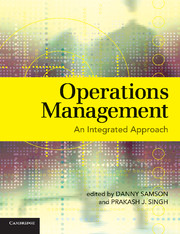Book contents
- Frontmatter
- Contents
- List of Contributors
- Preface
- Acknowledgements
- Part I Operations within Organisations – Building Blocks
- Part II Approaches to Understanding OM
- Part III Moving Forward with OM – Creating Competitive Advantage
- Part IV Challenges and Opportunities in Operations
- 11 Managing Risk in Operations
- 12 Sustainability in Operations Management
- 13 Operations Management in Different Settings
- Part V Case Studies
- Index
- References
11 - Managing Risk in Operations
Published online by Cambridge University Press: 05 June 2012
- Frontmatter
- Contents
- List of Contributors
- Preface
- Acknowledgements
- Part I Operations within Organisations – Building Blocks
- Part II Approaches to Understanding OM
- Part III Moving Forward with OM – Creating Competitive Advantage
- Part IV Challenges and Opportunities in Operations
- 11 Managing Risk in Operations
- 12 Sustainability in Operations Management
- 13 Operations Management in Different Settings
- Part V Case Studies
- Index
- References
Summary
Learning objectives
After reading this chapter, you should be able to:
appreciate that operations management decisions involve not just costs and benefits, but also risk factors
understand risk and its management frameworks
know how to identify and take risks into account in operational decision-making
incorporate risk factors into major decision areas such as technology choices, capacity choices, and other areas of operations
identify the key risks and be able to evaluate them and account for them in supply chains, not just in-house operations.
Box 11.1: Management challenge: PETRONAS
Consider the risks faced by the Malaysian oil and gas company PETRONAS. This company explores for oil and gas and then develops these assets into operating refineries and downstream petrochemical plants. In addition it operates pipelines all over the world and a large fleet of ships. Some of the risks this company faces include:
When PETRONAS explores by drilling for oil and gas, up to $100 million can be spent in any location, with a relatively low probability of success in finding significant deposits (only about one in eight developments is successful overall).
There is technical risk in operations, such as with new technology and plant reliability.
Marketing risk involves concerns about the future prices and demand for oil, gas and other petroleum and chemical products and related services.
PETRONAS operates in many countries where there is political uncertainty. PETRONAS has had to do business with ‘warlords’ and hence faces risk of asset nationalisation, sabotage etc.
Economic risk such as associated with currency fluctuation pervades the income stream of this company, which employs and pays most of its staff in Malaysian currency, but sells its products in US dollars.
[…]
Information
- Type
- Chapter
- Information
- Operations ManagementAn Integrated Approach, pp. 325 - 350Publisher: Cambridge University PressPrint publication year: 2008
